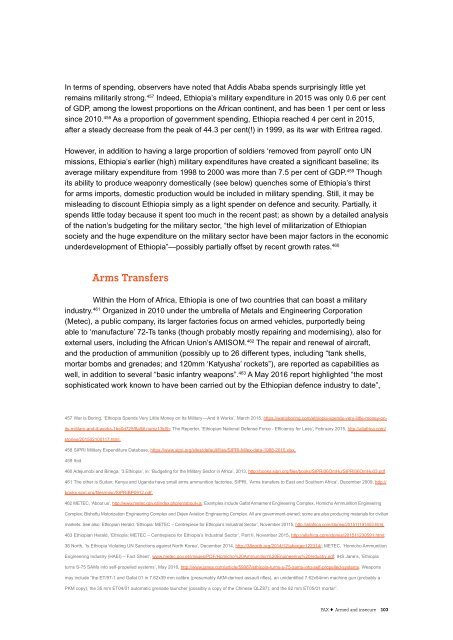Armed and insecure
pax-report-horn-of-africa-armed-and-insecure
pax-report-horn-of-africa-armed-and-insecure
You also want an ePaper? Increase the reach of your titles
YUMPU automatically turns print PDFs into web optimized ePapers that Google loves.
In terms of spending, observers have noted that Addis Ababa spends surprisingly little yet<br />
remains militarily strong. 457 Indeed, Ethiopia’s military expenditure in 2015 was only 0.6 per cent<br />
of GDP, among the lowest proportions on the African continent, <strong>and</strong> has been 1 per cent or less<br />
since 2010. 458 As a proportion of government spending, Ethiopia reached 4 per cent in 2015,<br />
after a steady decrease from the peak of 44.3 per cent(!) in 1999, as its war with Eritrea raged.<br />
However, in addition to having a large proportion of soldiers ‘removed from payroll’ onto UN<br />
missions, Ethiopia’s earlier (high) military expenditures have created a significant baseline; its<br />
average military expenditure from 1998 to 2000 was more than 7.5 per cent of GDP. 459 Though<br />
its ability to produce weaponry domestically (see below) quenches some of Ethiopia’s thirst<br />
for arms imports, domestic production would be included in military spending. Still, it may be<br />
misleading to discount Ethiopia simply as a light spender on defence <strong>and</strong> security. Partially, it<br />
spends little today because it spent too much in the recent past; as shown by a detailed analysis<br />
of the nation’s budgeting for the military sector, “the high level of militarization of Ethiopian<br />
society <strong>and</strong> the huge expenditure on the military sector have been major factors in the economic<br />
underdevelopment of Ethiopia”—possibly partially offset by recent growth rates. 460<br />
Arms Transfers<br />
Within the Horn of Africa, Ethiopia is one of two countries that can boast a military<br />
industry. 461 Organized in 2010 under the umbrella of Metals <strong>and</strong> Engineering Corporation<br />
(Metec), a public company, its larger factories focus on armed vehicles, purportedly being<br />
able to ‘manufacture’ 72-Ts tanks (though probably mostly repairing <strong>and</strong> modernising), also for<br />
external users, including the African Union’s AMISOM. 462 The repair <strong>and</strong> renewal of aircraft,<br />
<strong>and</strong> the production of ammunition (possibly up to 26 different types, including “tank shells,<br />
mortar bombs <strong>and</strong> grenades; <strong>and</strong> 120mm ‘Katyusha’ rockets”), are reported as capabilities as<br />
well, in addition to several “basic infantry weapons”. 463 A May 2016 report highlighted “the most<br />
sophisticated work known to have been carried out by the Ethiopian defence industry to date”,<br />
457 War is Boring, ‘Ethiopia Spends Very Little Money on Its Military — And It Works’, March 2015, https://warisboring.com/ethiopia-spends-very-little-money-onits-military-<strong>and</strong>-it-works-1be0d725f8a9#.numz13k0b;<br />
The Reporter, ‘Ethiopian National Defense Force - Efficiency for Less’, February 2015, http://allafrica.com/<br />
stories/201502100117.html.<br />
458 SIPRI Military Expenditure Database, https://www.sipri.org/sites/default/files/SIPRI-Milex-data-1988-2015.xlsx.<br />
459 Ibid.<br />
460 Adejumobi <strong>and</strong> Binega, ‘3.Ethiopia’, in: ‘Budgeting for the Military Sector in Africa’, 2013, http://books.sipri.org/files/books/SIPRI06OmHu/SIPRI06OmHu03.pdf.<br />
461 The other is Sudan; Kenya <strong>and</strong> Ug<strong>and</strong>a have small arms ammunition factories. SIPRI, ‘Arms transfers to East <strong>and</strong> Southern Africa’, December 2009, http://<br />
books.sipri.org/files/misc/SIPRIBP0912.pdf.<br />
462 METEC, ‘About us’, http://www.metec.gov.et/index.php/en/about-us. Examples include Gafat Armament Engineering Complex, Homicho Ammunition Engineering<br />
Complex, Bishoftu Motorization Engineering Complex <strong>and</strong> Dejen Aviation Engineering Complex. All are government-owned; some are also producing materials for civilian<br />
markets. See also: Ethiopian Herald, ‘Ethiopia: METEC – Centrepiece for Ethiopia’s Industrial Sector’, November 20115, http://allafrica.com/stories/201511191403.html.<br />
463 Ethiopian Herald, ‘Ethiopia: METEC – Centrepiece for Ethiopia’s Industrial Sector’, Part II, November 2015, http://allafrica.com/stories/201511230591.html;<br />
38 North, ‘Is Ethiopia Violating UN Sanctions against North Korea’, December 2014, http://38north.org/2014/12/aberger122314/; METEC, ‘Homicho Ammunition<br />
Engineering Industry (HAEI) – Fact Sheet’, www.metec.gov.et/images/PDF/Homicho%20Ammunition%20Engineering%20Industry.pdf; IHS Jane’s, ‘Ethiopia<br />
turns S-75 SAMs into self-propelled systems’, May 2016, http://www.janes.com/article/59987/ethiopia-turns-s-75-sams-into-self-propelled-systems. Weapons<br />
may include “the ET/97-1 <strong>and</strong> Gafat 01 in 7.62x39 mm calibre (presumably AKM-derived assault rifles), an unidentified 7.62x54mm machine gun (probably a<br />
PKM copy), the 35 mm ET04/01 automatic grenade launcher (possibly a copy of the Chinese QLZ87), <strong>and</strong> the 82 mm ET05/01 mortar”.<br />
PAX ! <strong>Armed</strong> <strong>and</strong> <strong>insecure</strong><br />
103


